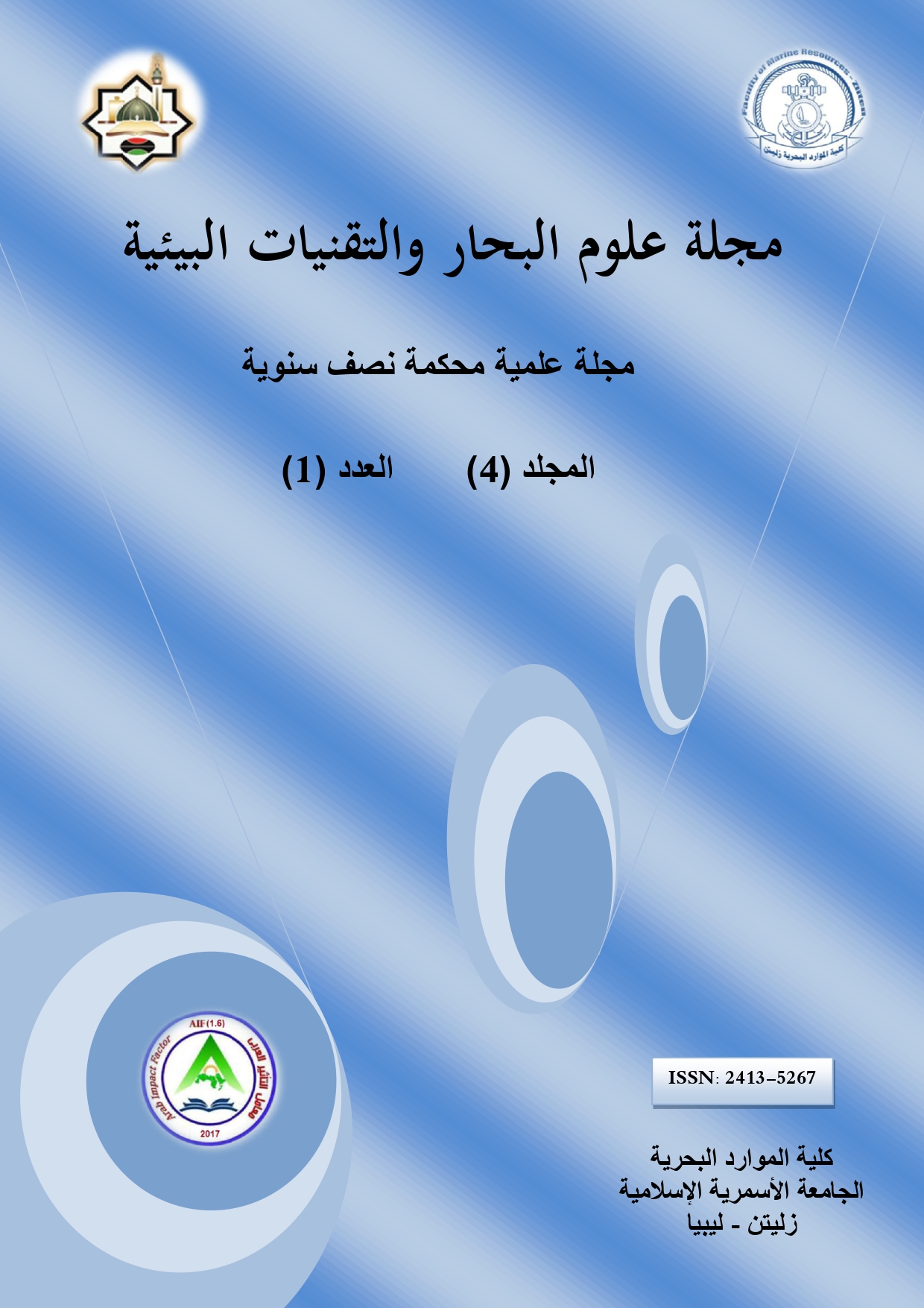دراسة أولية للعوالق النباتية للطبقة السطحية لمياه حوض سد وادي غان
DOI:
https://doi.org/10.59743/jmset.v4i1.86الكلمات المفتاحية:
Epilimnion، الديتومات، العوالق الخضراء، الخضراء المزرقة، العوامل الفيزيوكيميائيةالملخص
تشكل العوالق النباتية دورا مهما وجوهرياً في البيئات المائية حيث أنها تمثل المنتج الأول للمادة الغذائية والطاقة التي تعتمد عليها باقي كافة أفراد السلاسل الغذائية بالأوساط المائية حيث تؤدي بعض العوامل الفيزيوكيميائية كدرجة الحرارة واختراق الضوء وحركة المياه والمغذيات دورا هاما في توزيع العوالق وحدوث الطبقات في الأحواض المائية إلى جانب العوامل الأخرى. تتظافر هذه العوامل مع بعضها البعض لتحديد نوعية وجودة المياه وكذلك الكائنات الحية بالأوساط المائية. في هذه الدراسة تم جمع عينات المياه من الطبقة السطحية (Epilimnion or Euphotic Zone) بحوض مياه سد وادي غان خلال نهايات فصل الشتاء وحتى بدايات فصل الصيف وذلك لدراسة أنواع العوالق النباتية المتواجدة بها معمليا بواسطة الميكروسكوب، أيضا تم قياس بعض العناصر الفيزيوكيميائية حقليا مباشرة، أما البعض الأخر فقد تم قياسه معمليا وفق الطرق القياسية. أظهرت نتائج هذه الدراسة للعوالق النباتية المتواجدة بالطبقة السطحية للمياه المدروسة بمياه سد وادي غان خلال فصل الربيع تواجد 3 مجموعات شائعة وسائدة خلال فترة الدراسة منها مجموعة الديتومات (Bacillariophyceae) حيث تم التعرف على 8 أنواع من هذه المجموعة, أما مجموعة الطحالب الخضراء (Chlorophyceae) فقد تم التعرف على 6 أنواع منها, أما بالنسبة لمجموعة العوالق الخضراء المزرقة (Cyanophyceae (Cyanoprocaryota فقد تم التعرف على 4 أنواع من هذه المجموعة, أما بالنسبة لمجموعة الطحالب الخضراء المصفرة (Xanthophyceae) فقد ثم التعرف على نوع واحد فقط من هذه المجموعة. وتواجدت معظم مجموعات الطحالب من حيث الوفرة والتنوع للعينات المدروسة خلال نهايات شهر مارس, على الرغم من ملاحظة عدم تواجدها بنفس الوفرة خلال نهايات شهر فبراير وهذا قد يكون بسبب ارتفاع مستويات الأكسجين الذائب (9.8) مجم/لتر وارتفاع درجة pH (12.06) وانخفاض درجات حرارة المياه ºC12 وأيضا انخفاض نسبة الأملاح الذائبة الكلية (0.2) جم/لتر, أما خلال شهر يونيو فقد لوحظ انخفاض في مجموعات الطحالب ما عدا مجموعة الطحالب الخضراء التي أظهرت تواجدا سائدا لنوع واحدا منها بالرغم من الانخفاض في تركيز الأكسجين المذاب (4.1) مجم/لتر وأيضا درجة pH (6.2) مع الزيادة في تركيز الفوسفور (0.6) مجم/لتر ودرجة حرارة المياه ºC 26 والذي قد يكون بسبب ارتفاع العسورة نسبيا (90.8) مجم/لتر والذي أدى بدوره أدى الى تناقص أنواع العوالق النباتية خلال تلك الفترة نتيجة تدفق المياه إلى الحوض بسبب هطول الأمطار وذلك خلال بدايات جمع العينات لهذه الدراسة. يمكن أن نستنتج من خلال هذه الدراسة أن العوامل البيئية الفيزيائية والكيميائية وبعض الأنشطة البشرية لها تأثير ودور كبير في تواجد وتنوع أصناف وأنواع العوالق في هذا الحوض.
التنزيلات
المراجع
Abrantes N., Antunes S.C., Pereira M.J., and Gonçalves F. (2006). Seasonal succession of cladocerans and phytoplankton and their interactions in a shallow eutrophic lake (Lake Vela, Portugal). Acta Oecologica, 29(1): 54-64.
Abujam S.K.S., Paswan G., Dakua S., and Saikia A.K. (2012). Faunal diversity and ecological status of Maijan beel (Wetland). Fishing Chimes, 32(8): 43-48.
Barinova S.S., Anissimova O.V., Nevo E., Jarygin M.M., and Wasser S.P. (2004). Diversity and ecology of algae from the Nahal Qishon river. Plant biosystems, 138(3): 245-259.
Buzzi F. (2002). Phytoplankton assemblages in two sub-basins of Lake Como. J. of Limnology, 61(1): 117-128.
Celekli A. (2006). Net Diatom (Bacillariophyceae) Flora of Lake Gölköy (Bolu). Turkish J. of Botany, 30(5): 359-374.
Celekli A., and Külköylüoğlu O. (2007). On the relationship between ecology and phytoplankton composition in a karstic spring (Cepni, Bolu). Ecological Indicators, 7(2): 497-503.
Das S.K., and Chakrabarty D. (2007). Limnological survey of three tropical water reservoirs in Eastern India. Acta botánica malacitana, (XXXII): 5-16.
Descy J.P., Servais P., Smitz J.S., Billen G., and Everbecq E. (1987). Phytoplankton biomass and production in the River Meuse (Belgium). Water Research, 21(12): 1557-1566.
Farahani F., Korehi H., Mollakarami S., Skandari S., Ghasem S., Zafaani G., and Shashm Z.M.C. (2006). Phytoplanktonic diversity and nutrients at the Jajerood River in Iran. Pakistan Journal of Biological Science, 9(9): 1787-1790.
Fathi A.A., Abdelzaher H.M.A., Flower R.J., Ramdani M., and Kraïem, M.M. (2001). Phytoplankton communities of North African wetland lakes: the CASSARINA Project. Aquatic Ecology, 35(3-4): 303-318.
Finlay J.C., Khandwala S., and Power M.E. (2002). Spatial scales of carbon flow in a river food web. Ecology, 83(7): 1845-1859.
Fisher S.G., and Grimm N.B. (1991). Streams and disturbance: Are cross-ecosystem comparison usful? In Comparative Analysis of Ecosystems. Patterns, Mechanisms and the ories (Cole J., Lovett G., and Findaly S., Eds.), pp.: 196-221, Springer-Verlag, New York.
Huisman J., Matthijis H.C.P., and Visser P.M. (2005). Harmful Cyanobacteria. Aquatic Ecology Series, Series Vol.: 3, Springer, Netherlands.
Ilja K.R.N.O., Šporka F., Štefkova E., Tirjakova E., Bitusik P., Bulankova E., Lukas J., Illesova D., Derka T., Tomajka T., and Èerny J. (2006). Ecological study of a high-mountain stream ecosystem (Hincov potok, High Tatra Mountains, Slovakia). Acta Soc. Zool. Bohem, 69: 299-316.
Ishida N., Mitamura O., and Nakayama M. (2006). Seasonal variation in biomass and photosynthetic activity of epilithic algae on a rock at the upper littoral area in the north basin of Lake Biwa, Japan. Limnology, 7(3): 175-183.
Komarek J., and Jankovska V. (2002). Review of the Green Algal Genus Pediastrum; Implication for pollaen-analytical Research. Bibliotheca Phycologica. Cramer J. Berlin-Stuttgart, 108: 127-128.
Lange-Bertalot H., and Metzeltin D. (1996). Ecology–Diversity–Taxonomy. Indicators of oligotrophy–800 taxa representative of three ecologically distinct lake types. Iconographia Diatomologica, 2(1): 1-390.
Lindstrom E.A., Johansen S.W., and Saloranta T. (2004). Periphyton in running waters—long-term studies of natural variation. In The Atna River: Studies in an Alpine—Boreal Watershed, pp.: 63-86, Springer, Dordrecht.
Minshall G.W. (1978). Autotrophy in stream ecosystems. BioScience, 28(12): 767-771.
Munn M.D., Black R.W., and Gruber S.J. (2002). Response of benthic algae to environmental gradients in an agriculturally dominated landscape. Journal of the North American Benthological Society, 21(2): 221-237.
Nicholls K. (1997). Planktonic green algae in western Lake Erie: the importance of temporal scale in the interpretation of change. Freshwater Biology, 38(2): 419-425.
Orsini L., Sarno D., Procaccini G., Poletti R., Dahlmann J., and Montresor M. (2002). Toxic Pseudo-nitzschia multistriata (Bacillariophyceae) from the Gulf of Naples: morphology, toxin analysis and phylogenetic relationships with other Pseudo-nitzschia species. European Journal of Phycology, 37(2): 247-257.
Peterson C.G. (1996). Response of benthic algal communities to natural physical disturbance. Algal Ecology, 375-402.
Potapova M., and Charles D.F. (2003). Distribution of benthic diatoms in US rivers in relation to conductivity and ionic composition. Freshwater Biology, 48(8): 1311-1328.
Reynolds C.S. (1980). Phytoplankton assemblages and their periodicity in stratifying lake systems. Ecography, 3(3): 141-159.
Rimet F., Druart J.C., and Anneville O. (2009). Exploring the dynamics of plankton diatom communities in Lake Geneva using emergent self-organizing maps (1974–2007). Ecological Informatics, 4(2): 99-110.
Robarts R.D., and Zohary T. (1987). Temperature effects on photosynthetic capacity, respiration, and growth rates of bloom-forming cyanobacteria. New Zealand Journal of Marine and Freshwater Research, 21(3): 391-399.
Round F.E. (2002). The Biology of Algae, 2nd. ed., Edward Arnold, London.
Sitkowska M. (1992). Taksony rodzaju Pediastrum Meyen wystepujace w stawach Lodzi i okolic. Acta Universitatis Lodziensis. Folia Botanica, 9: 47-104.
Stevenson R.J., and Smol J.P. (2003). Use of Algae in Environmental Assessments. In Freshwater Algae of North America: Ecology and Classification, pp. 775-804. Elsevier Inc.
Subyani A.M. (2005). Hydrochemical identification and salinity problem of ground-water in Wadi Yalamlam basin, Western Saudi Arabia. Journal of Arid Environments, 60(1): 53-66.
التنزيلات
منشور
إصدار
القسم
الرخصة
الحقوق الفكرية (c) 2018 مجلة علوم البحار والتقنيات البيئية

هذا العمل مرخص بموجب Creative Commons Attribution 4.0 International License.












